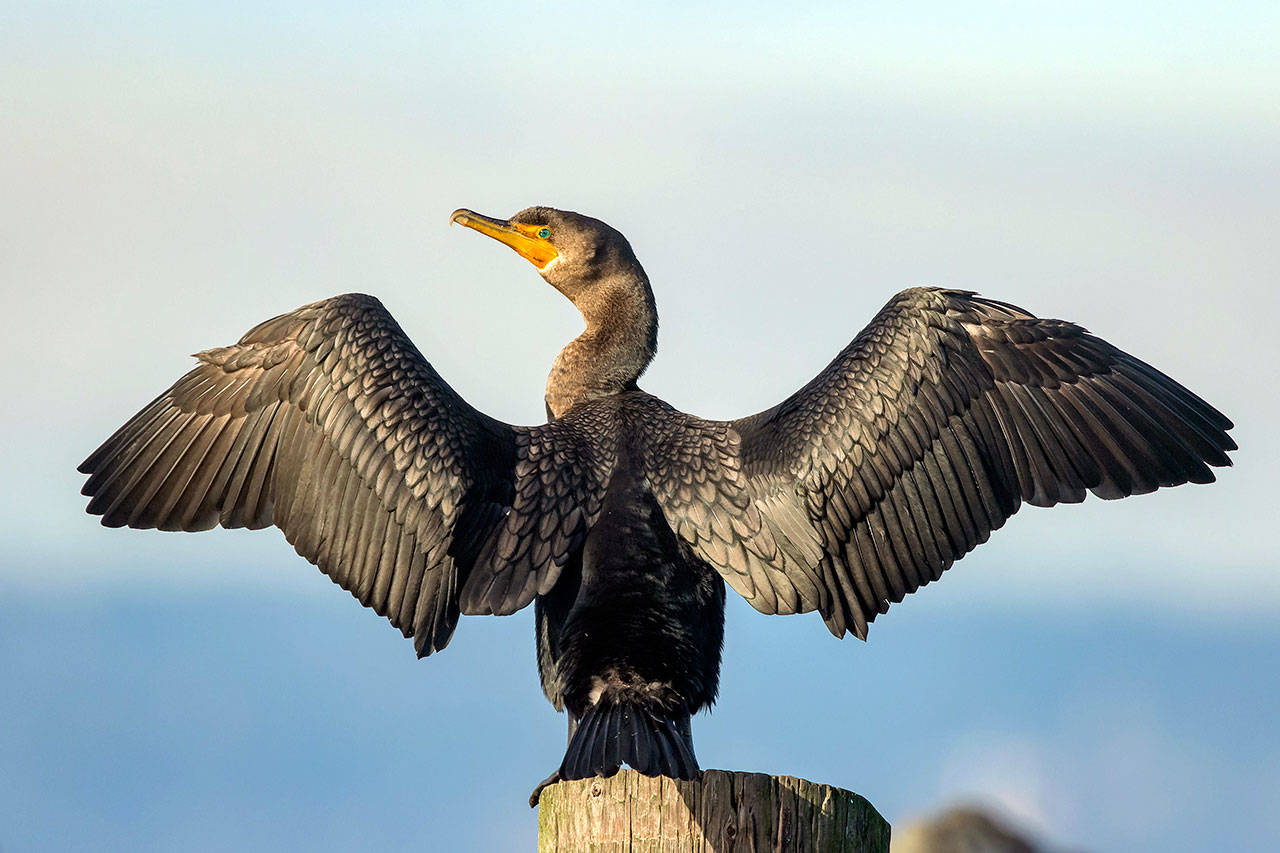By Dianna Moore
Grays Harbor Audubon
One of my long-time acquaintances has now been retired from running the Ocean Shores Visitor Information Center for several years and has found various ways to keep herself occupied. One of them is watching the birds that fight for position on a buoy on Duck Lake. Helen can see the buoy from her desk and from her favorite chair, and has been amused by the comings and goings of the regulars who frequent that perch. Sometimes the bird is a gull, but more often it is a Double-crested Cormorant, wings spread as is the one featured here in Gregg Thompson’s photo. This pose is to allow the bird to better dry its wings which become thoroughly soaked by its underwater diving to capture prey. Read on for more interesting information on this very common bird.
General Description: Double-crested Cormorants can be found almost everywhere in the Pacific Northwest including the Grays Harbor area. They are a large bird with a small head and long, flexible necks. They are a shiny black or dark brown in color with a patch of orange-yellow skin at the base of their bills. They have a slender hooked bill. They get their name from two whitish tufts of feathers behind their eyes that form on both sexes during their breeding season. Immature birds have pale upper breast feathers and darker bellies. Both sexes are about 27.6 to 37.4 inches in length, with a wing span of 45 to 48 inches, and weigh from 42.3 to 88.2 ounces. In flight they have a pronounced kink in their neck, one of the ways to tell them from the other two local cormorants, the Pelagic and the Brandt’s.
Habitat: These cormorants can be found on both coastal and inland waters and both salt and fresh-water venues. They stay within sight of land, usually find perches on pilings, rocks, and sandbars, and any sites that look to offer good fishing opportunities. Their breeding colonies are usually outcroppings of rock, sandbars, or small islands. They can also nest or roost in the relative safety of trees if predators are present.
Behavior: Double-crested Cormorants nest in large colonies, form dense nocturnal roosts, and travel in flocks. Out here at the coast they can be seen heading out to the beach in the mornings and returning inland in the evenings. They stay in shallow waters while foraging near land, diving from the surface of the water to pursue prey underwater, and using their broad, webbed feet to propel them rather than their wings as do most water birds. Because they need to be able to reduce buoyancy for their underwater fishing, their feathers get waterlogged easily, hence their pose, wings outstretched to dry off. During breeding season males perform a wing-waving display to show off their head tufts and neck colors.
Diet: Cormorants eat a variety of prey depending on availability, including slow-moving schools of small fish, crustaceans, some amphibians and insects.
Nesting: Unpaired males begin scouting for a nest site first, then go looking for a mate. The male brings nesting materials to the female and she builds the nest of a platform of sticks and found debris, lined with dry grasses, usually on a rocky cliff near water, but it can also be on the ground on an island, or even in a tree. As the nest accumulates dry materials it is held together by the increasing deposits of droppings. Both parents incubate the three to four eggs 25 to 28 days and both also regurgitate food for the hatched young for approximately 21 to 28 days. After leaving the nest the young form into groups called creches and roam through the colony, returning to the nest site to be fed. They are completely independent of their parents at about 10 weeks.
Migration: Although some cormorants migrate from east of the Cascades out to the coast from October through March, most birds remain permanent residents of the coast and Puget Sound.
Conservation Status: Double-crested Cormorant numbers have been increasing since the ban of DDT. They are sensitive to human disturbance to their colonies and are still persecuted as predators of commercial fish at hatcheries. It is thought that unfavorable ocean conditions are now causing a decline.
When and Where to Find on Grays Harbor: This is the only cormorant likely to be found on fresh water, and they are common all year throughout Grays Harbor. They nest on islands in Grays Harbor and on rocky islets along the coast. Maybe you too can find your very own spot to watch a buoy or piling for this sun-seeking bird.


